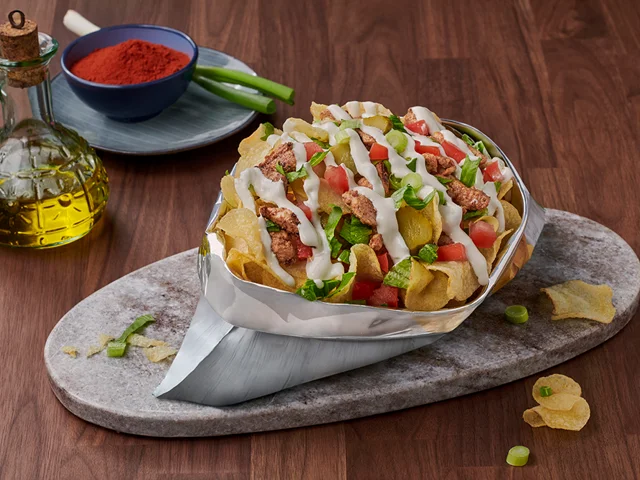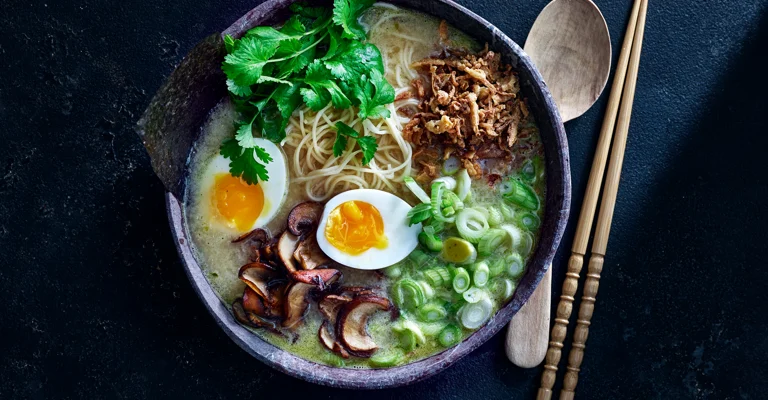


Yes, ready-made chicken stock works well for this chicken ramen recipe. To deepen the flavor, simmer the stock with ginger, spring onions, and chili. Adding dried shiitake mushrooms will also give a rich umami taste. Be sure to boil the stock with these ingredients, then let it simmer to blend the flavors thoroughly. This enhances the broth, giving you a delicious base for your chicken ramen without needing to make the stock from scratch.
For authentic chicken ramen, choose traditional ramen noodles made from wheat flour, salt, water, and kansui. They are known for their unique chewy feel and taste. If you want to mix things up, straight or wavy ramen noodles, udon, soba, or somen also work well. Wavy noodles are particularly good with lighter broths. If you are using instant noodles, be careful not to overcook them, as they can quickly become too soft. Cook them for a shorter time so they stay firm in your broth. Whether using fresh or dried noodles, cook them as the package directs to get them just right so they add to the rich taste of your chicken ramen.
Yes, you can! Making your chicken ramen broth in advance saves time and deepens the flavor. Store the broth in the fridge for up to 2 days. If you need to keep it longer, freeze it without the noodles or chicken. Reheat the broth until hot when you are ready to eat, then add the noodles and other toppings. For more flavor, simmer the broth with ginger, spring onions, and chili before storing, then strain out these ingredients. When reheated, the broth will taste richer.
Elevate your chicken ramen with these tips that will help you create a truly gourmet experience at home.
Carefully arrange the toppings for a stunning presentation. Instead of mixing all the ingredients, group each topping separately around the bowl. This not only enhances the visual appeal but also lets you enjoy the distinct flavors and textures of each component.
To maintain the fresh taste of your chicken ramen, store the broth, toppings, and noodles separately. Keep the broth in a sealed container in the fridge for up to 2 days. Also, store the toppings and noodles in different containers to prevent sogginess. When reheating, reheat the broth and noodles separately, then combine with the stored toppings for the best taste. Note that some toppings, like noodles and fresh herbs or vegetables, might be better prepared fresh instead of keeping them for later.
Cook ramen noodles just before serving to ensure they remain chewy. Follow the package instructions for cooking time, but slightly undercook them if they will sit in hot broth for a while. This prevents them from becoming overly soft. After cooking, rinse the noodles briefly under cold water to stop the cooking process and remove excess starch.
Ramen is a popular Japanese soup with chewy noodles, rich broth, and a variety of toppings. It is built from bottom to top of a deep ramen bowl in a very specific order to get the flavors and textures just right. At the bottom, you have a flavorful seasoning sauce, followed by hot broth, freshly cooked noodles, and then meat, vegetables, and other toppings like fresh herbs. Serve immediately and enjoy the warm, comforting flavors. This combination and layering ensure that each component is showcased beautifully and contributes to a harmonious, authentic, and delicious bowl of chicken ramen.
For more recipes featuring chicken, try our chicken and prawn pad Thai, Chicken Cannelloni with Mushroom, and butter chicken mac and cheese.
A homemade ramen broth is the heart of the dish, providing a rich and warm flavor base. Simmered with aromatics like ginger, garlic, and spring onions, the taste deepens deliciously. This flavorful broth not only warms you up but also brings all the ingredients together, giving you a delightful eating experience with all the flavors adding up to classic Japanese cuisine. When prepared with care, the chicken broth becomes the soul of your ramen, offering a savory and comforting foundation for the other ingredients.
Every ramen needs a deep, savory flavor, which you achieve with the seasoning sauce or 'tare'. This recipe uses miso, tahini, and sesame oil mixed with egg yolk. This concentrated seasoning is crucial for giving ramen its distinctive taste. The miso provides a rich umami flavor, while the tahini and sesame oil add a creamy, slightly sweet element. The yolks add an indulgent creaminess and make the soup coat the noodles wonderfully in a smooth, creamy way. The seasoning sauce forms the core of the dish's taste, ensuring every slurp is packed with layered flavors.
Making a delicious bowl of chicken ramen involves a blend of toppings. We opted for tender chicken, chewy noodles, umami butter-fried mushrooms, sharp spring onions, salty nori sheets, crispy fried onions, and fresh coriander. Mushrooms like shiitake or oyster add a rich, earthy flavor and soak up the broth's essence. Choose tender, juicy chicken breast fillets for the best taste and texture. The spring onions bring a sweet, caramelized note, while the coriander adds a fresh, citrusy touch, making your ramen both visually appealing and delicious. Ramen noodles are a key element, offering a superior texture that absorbs the broth beautifully. Whether fresh or dried, high-quality noodles maintain their springiness when cooked, delivering a satisfying bite with a good chewiness.
Ramen has captivated global appetites with its origins in Japan, where it was adapted and refined from Chinese wheat noodles into the well-loved noodle soup we enjoy today. This traditional Asian dish is ideal for dinner, offering a comforting and flavorful meal that is both satisfying and versatile. Over time, ramen has evolved to include regional variations in Japan, each with distinct styles and ingredients that reflect local tastes and cultural influences.
Enhance your chicken ramen with delicious sides like Japanese dumplings, gyoza, lightly salted edamame, and tangy seaweed salad. For a touch of crunch, try tempura, featuring lightly battered and deep-fried vegetables or shrimp.
Preparing chicken ramen at home allows you to enjoy a traditional Asian dish with everyone around the table able to choose their favorite toppings. This makes it a delightful option for dinner that showcases the depth and diversity of Asian cuisine.
Shake things up with different types of toppings. Go for greens with crisp bok choy that offers a satisfying crunch, while bamboo shoots bring a distinct, earthy taste. Different mushrooms, such as fresh shiitake, oyster, or enoki, add deep, umami flavors that complement the chicken broth. You can also try sweet corn for sweetness, bean sprouts or julienned carrots for extra crunch, spicy kimchi or other pickled vegetables for a tangy kick that contrasts with the rich soup. Feel free to experiment with other types of tender meat besides chicken, such as beef.
Finish your ramen with a touch of chili oil for heat or a dash of lime juice for tang. Instead of the usual boiled egg, you can experiment with a fried or poached egg, or serve with a traditional ramen egg. Ramen eggs, also known as 'ajitsuke tamago' or 'ajitama,' are soft-boiled eggs marinated in a savory marinade of soy sauce, mirin, and sometimes sugar. These eggs add a rich and flavorful element to the dish.
For an added flavor, incorporate soy sauce into the broth. Soy sauce adds a rich, salty, and slightly tangy flavor. You can also experiment with a splash of rice vinegar to add a subtle tang that balances the flavors beautifully.

Fall in love with pasta all over again, as you serve your loved ones creamy dishes made richer with Puck—and your special touch. Our inspiring recipes, general guidelines, and detailed articles will set you on the path to culinary creativity. With Puck’s entire range of cooking creams and sauces that meet your high standards, you’ll love putting your personal spin on pasta.